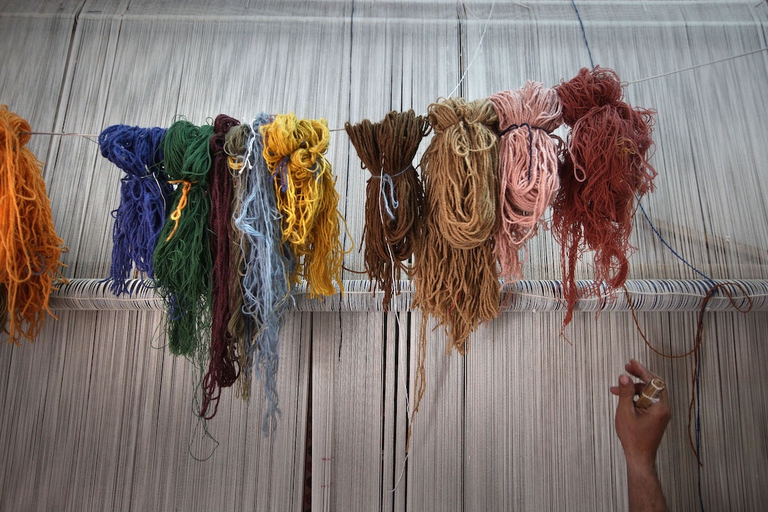
By recovering clothes discarded in the West, Togolese designer Amah Ayiv gives them new life through his high fashion creations.
Today the continent is evermore relevant to the fashion industry worldwide. Global markets are not only looking to it as a sourcing destination but also as a source of inspiration. Colour Trends Whether it is for bright colours, patterns or prints the world is looking to African fashion. Tropical landscapes with lush green forests, fruits
Today the continent is evermore relevant to the fashion industry worldwide. Global markets are not only looking to it as a sourcing destination but also as a source of inspiration.
Colour Trends
Whether it is for bright colours, patterns or prints the world is looking to African fashion. Tropical landscapes with lush green forests, fruits and exotic flowers are great sources of inspiration for designers worldwide. From traditional patterns to the animal prints that have now become a trademark in the fashion world, this fresh and new print language is heavily influenced by the continent’s style.
Too many of its countries have been dependent on second-hand clothing imports from Western countries. Times have now changed. In order to move away from this trend, a number of local designers are working hard towards creating fashion collections entirely made in Africa. “There’s a political system which has been going on for decades trying to keep our countries from branding themselves. We have enough resources and our eyes are now open,” explains Carine Zoe Umutoni, the fashion designer behind Onyx.
East Africa especially is becoming a crucial hub for garment sourcing. 37 out of 54 of the continent’s countries are cotton producers, and Kenya and Ethiopia are leading the way in the textile industry. In the last two years, the latter has seen European brands such as Primark and H&M come to source apparel. At Origin Africa, the continent’s largest trade fair for cotton, textile and apparel held in Addis Abeba, Ethiopia in October, Teta Isibo, jewellery and accessories designer at Inzuki Designs, told us: “I am proud to be here as a representative of Rwanda. You can now source from Africa, which is a growing trend among international brands.”
The challenges. So why are Western companies not buying more from there? It all comes down to trust says Keren Long from Ethical Apparel Africa, a social enterprise providing consultancy and sourcing support for brands developing an African manufacturing base. One thing is clear, the potential is there. Artisans across the continent benefit from knowing unique skills and techniques, often passed down from generation to generation, and producing beautiful local handicrafts. What they still need to work on, Long points out, is on-time delivery, consistency in production, increased quality, ethical traceability and environmental procedures.
A celebration of Africa can easily escalate into cultural appropriation, falling into the stereotype of the continent as the tribal and ethnic land, becoming offensive. For example, many decry how the Italian fashion house Valentino crossed the line with its Spring-Summer 2016 show at Paris Fashion Week in October by presenting a collection inspired by the “wild and tribal” featuring mostly white models wearing cornrows, a hairstyle widespread throughout the continent. “African fashion is seen as tribal and ethnic and will continue to be seen so if local designers continue making blazers Chanel style with local fabrics,” according to Anna Getaneh, the creative soul behind African Mosaique, whose collections are sourced and manufactured in the continent. There’s a need for something new, she believes, in order to break away from the tribal and ethnic label.
The continent offers many opportunities. Whilst local designers are redefining fashion on their own terms, fashion globetrotters around the world are heading there to find inspiration. This is a visual celebration of its beauty and increasing economic relevance. As pointed out by the Twitter campaign #TheAfricaTheMediaNeverShows, its home-grown ingenuity and creativity too often go untold.
Siamo anche su WhatsApp. Segui il canale ufficiale LifeGate per restare aggiornata, aggiornato sulle ultime notizie e sulle nostre attività.
![]()
Quest'opera è distribuita con Licenza Creative Commons Attribuzione - Non commerciale - Non opere derivate 4.0 Internazionale.
By recovering clothes discarded in the West, Togolese designer Amah Ayiv gives them new life through his high fashion creations.
All catwalks in July will be broadcast online: after Paris, it’s Milan Digital Fashion Week’s turn. And the biggest beneficiary is the environment.
The book Fashion Industry 2030 aims to contribute to reshaping the future through sustainability and responsible innovation. An exclusive opportunity to read its introduction.
From fashion to design, from architecture to construction, biomaterials and their applications are constantly multiplying. And designers are responding to this revolution in many different ways.
A new study on linen, presented at the Milano Unica trade show, highlights the material’s numerous advantages and low environmental impact.
Victor Papanek spearheaded social and sustainable design based on political awareness rather than consumerism. A biography of the author of Design for the Real World.
Two world-famous designers, Ross Lovegrove and Marcel Wanders, on the relationship between plastic and design. The stimulus for this conversation was offered by an exhibition at the past Milan Design Week inviting 29 designers to rethink their approach to this (now) demonised material.
Getting people to consume less is important, but it’s not enough. There has to be a cultural shift, and design is likely to have a key role in transforming our approach to plastics.
A journey to discover leather tanneries in Dhaka, the capital of Bangladesh, among terrible working conditions, pollution and laws left unenforced.









